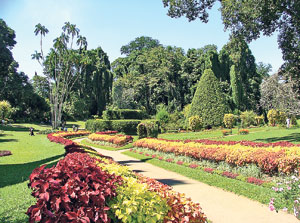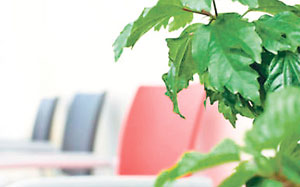The relationship between plants and human beings has always been profoundly important; All human cultures depend on plants in different ways, without exception.
Some 2500 years ago the Buddha described a forest full of trees as a peculiar organism of unlimited kindness and benevolence that makes no demands for its sustenance and extends generously the products of its life activity.
Before the rise of Christianity, nature, especially trees, were widely worshipped in many different cultures. In ancient Greece, the priests purified themselves before venturing to a sacred oak grove and calling out questions. According to legend, the trees answered in human voices. The Celts and their shamans the Druids, considered every oak tree to be endowed with sacred powers. In Christian times, we have Blessed Hildegard of Bingen and St. Francis speaking of plants and trees as divine wonders.
Plants and spirituality
Trees also served as the symbolic connection between the different levels of existence, the heavens above in its crown, the underworld beneath its roots and the world of human affairs around its girth. The Buddhist religious practice of conducting “bodhi poojas” (religious offerings and recitations) at the bodhi trees (Ficus religiosa) may be worth mentioning here.
Plants as oxygenators
Plants are also the only organisms capable of transforming sunlight into food energy, which all other forms of life ultimately depend upon. They are the organisms that make life in our biosphere possible: they make an otherwise lifeless environment habitable, arable and teaming with myriad of life forms that all ultimately depend on the green life force of plants.
Plants as air purifiers
The ability of plants to absorb chemicals from the environment has been demonstrated in many studies. Tests done by NASA have shown that common houseplants remove pollutants as they go through their natural process of photosynthesis—while plants draw in carbon monoxide, they also pick up airborne pollutants through small openings called stomata in the leaves and even through the root system.
They are effective at removing gases or volatile organic compounds such as formaldehyde, carbon monoxide, carbon dioxide, benzene, cigarette smoke, and ozone, which are harmful for us to breathe. These are found in personal care products as well as in paints, plastics, room deodorizers, adhesives and other day-to-day products.
 |
| Visiting a botanical gardens lowers blood pressure and reduces heart rate. |
Aloe Vera (Komarika-which is now a chief ingredient in a myriad of beauty products), Howea forsteriana (commonly called the Kentia palm- but not the one locally called by this name), spathyphyllum, common chrysanthemums, dracaena, philodendron, spider plants, and schefflera are among the better air filters.
Plants also offer wide varieties of food for both body and soul, as well as multitudes of medicines for all types of diseases, from the common cold to cancer.
Plant extracts have played a significant role in the development of many important drugs that have saved thousands of lives.
The hunt for new plant medicines is still on. Fruits, flowers, seeds, leaves, roots, bark all contain volatile liquids that can be distilled and used because of their very complex chemical makeup.
People are now interested in looking for alternative therapy systems and find them among the ancient healing traditions, which treat the body as a psycho-physical totality. Chinese herbalism, one of the most ancient healing traditions in the world has become hugely popular in recent years. Ayurvedic practices, aromatherapy and others are also steadily gaining acceptance among the mainstream.
According to the UNEP World Conservation Monitoring Centre, in the U.S. alone 56 percent of the top 150 prescribed drugs, are linked with discoveries made in the wild. This amounts to an economic value of $80 billion! Pharmaceutical companies are again looking at plant materials as possible sources for new drugs. The tropical forests are a huge reserve of bio and chemical diversity. It is estimated that of the approximately 250,000 tropical plant species less than one percent have been tested.
Yet, the few that have been tested have supplied the pharmaceutical companies with the raw materials of many of their most profitable and widely used drugs.
It may be of interest that our common fruit “katu aatha or anoda” (Anonas reticulata) has been found to contain a chemical which is ten times more potent than that used in chemotherapy for cancer patients.
Plants as mental catalysts
A study carried out by the American scientists Virginia I. Lohr and Caroline H. Pearson-Mims from the Departments of Horticulture and Landscape Architecture of the Washington State University proves that just looking at trees has a positive effect on people. The aim of the study was to compare the psychological and physiological perceptions of urban scenery with trees of different shapes, such as conical, globular and jutting out, with non-living objects.
The general mood of the test persons was studied by using computer graphics that showed an urban scene, firstly without trees and secondly with single, different shapes of trees.
The participants showed more positive emotions, such as happiness, friendliness and assertiveness, and less negative emotions, such as sadness, fear and annoyance, whilst looking at the urban scenery with trees. The positive emotions were especially strengthened when looking at the computer graphic with the jutting out trees. No difference in blood pressures and temperatures were recorded.
It can be said that the study clearly proves that trees have the effect of a calming catalyst on people, especially those who live in urban areas, and contribute to their well-being and better health. Because the positive effects were shown more by the trees with the jutting out shape, they should be used for landscaping in hospitals, rehabilitation centres etc, because people in these situations will benefit most.
Mary K. Honeyman, landscape architect at Oblinger, Mason, KS, USA concluded that urban vegetation presented important psychological benefits.
Her results showed reduced stress for groups that viewed
vegetative scenes and increased stress for those who viewed scenes without vegetation.
Other researchers have found that a window overlooking predominantly trees or other vegetation has repeatedly produced positive effects on the health of individuals in prisons and in hospitals. A study by Roger Ulrich, professor of architecture, Texas A&M, reported on the recovery of cholecystectomy patients in a suburban Pennsylvania hospital.
Twenty-three patients assigned to rooms with windows facing a natural scene had shorter postoperative hospital stays, received fewer negative evaluative comments in nurses’ notes and took fewer potent analgesics than did 23 patients in rooms with windows facing a brick wall.
In another study, Owen found that visiting a botanical gardens lowers blood pressure and reduces heart rate.
Other studies by Kaplan, Ulrich and fellow workers show that the presence of vegetation will speed recovery from stress.
Different studies show that activities like gardening are associated with health and reduce risk factors for coronary heart disease.
Could this be the reason for the hundreds of visitors, perhaps unknowingly, flocking to the plant shows held at the Vihara Maha Devi Park almost every weekend?
A Gallup Poll found that 40 percent of Americans reported feeling calmer and more relaxed around plants, and 37 percent agreed that one of the most satisfying aspects of gardening and working with plants is the peace and tranquility it brings.
Plants in the office
 |
| There's a positive relationship between plants at the workplace and the health of the office worker. |
Research by Fjeld and his fellow scientists (2002) into the effects of plants on the well-being and health of office workers shows that there is a positive relationship between plants at the workplace and the health of the office worker.
They also found a decline of health problems like fatigue, headaches and complaints like dry and sore throat and dry hands when plants and daylight lamps were placed in the office.
The presence of plants seems to have a positive effect on cognitive functioning in terms of attention recovery.
Even exposure to plants for a few minutes can lead to positive effects on cognitive functioning. Other research shows a positive relationship between plants and work productivity and a lower blood pressure.
Plants as therapy
Horticulture, in many different forms, has been used as a therapy or as an adjunct to therapy in the treatment of diseases.
Therapists and participants in horticultural therapy programmes report the positive benefits like social integration, increase of self-confidence, self-esteem and concentration, and learning of practical skills, structure and routine. Unruh (2004) studied 42 men and women in Nova Scotia (Canada) and compares the meaning of gardening for people with cancer and people without cancer.
He concludes that the possible meaning of gardening in daily life is diverse and dependent on individual interests, past gardening experiences and current circumstances.
The study revealed that gardening can be a possible coping strategy for stressful life experiences and can be beneficial for the physical, emotional, social and spiritual well-being.
The writer is the Vice-President/Hony. Editor-Horticultural & Flora Conservation Society
|



